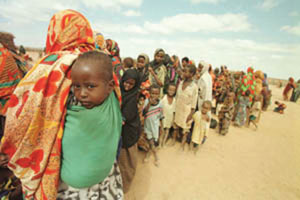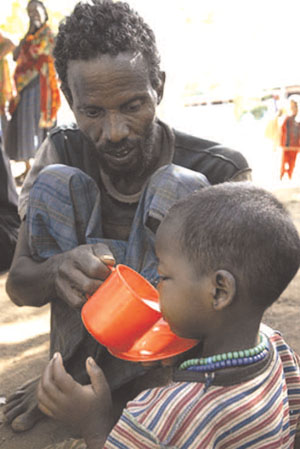8.7.2 Selective feeding programmes
There are two approaches to the actual distribution of food: targeted and blanket. Within these two approaches there are two kinds of programmes: supplementary feeding programmes (which may be ‘targeted’ or ‘blanket’) and therapeutic feeding programmes.
Targeted supplementary feeding programmes
In this approach supplementary food is restricted to those individuals identified as the most malnourished, or most nutritionally vulnerable or at risk during nutritional emergencies. This includes pregnant women, lactating mothers and young children under five years of age (see Figure 8.4). The main objective of a targeted supplementary feeding programme is to prevent the moderately malnourished from becoming severely malnourished and consequently, to reduce the prevalence of severe acute malnutrition and associated mortality.

Blanket supplementary feeding programme
In blanket supplementary feeding programmes (SFP) food is distributed as a temporary measure to all vulnerable members of a population at risk of becoming malnourished without identifying the most malnourished. The general objective of a blanket SFP is to prevent widespread malnutrition and mortality.
Therapeutic feeding programme
Therapeutic feeding programmes (TFPs) provide a rehabilitative diet together with medical treatment for diseases and complications associated with the presence of severe acute malnutrition.
The specific aim of TFPs is to reduce mortality among acutely severely malnourished individuals and to restore health through rehabilitating them. TFPs may be administered through the following venues:
- Therapeutic feeding centre (TFC)
- Nutrition rehabilitation unit (NRU) at a hospital or health facility
- Community-based therapeutic care (CTC/OTP) programme.
Figure 8.5 shows a five-year-old Khesna, who is severely malnourished, drinking therapeutic milk at the UNICEF-supported feeding unit of Bissidimo Hospital in East Harerghe Zone of Oromia Region. The milk is rich in micronutrients and is the first phase of a feeding regimen—eight times daily—that helps the body recover from the shock of malnutrition and conditions it to digest food. Khesna must initially be fed small portions, slowly.

What is the objective of blanket supplementary feeding?
It is temporary measure for all vulnerable members of a population at risk of becoming malnourished, without identifying the most malnourished, to prevent widespread malnutrition and mortality.
In conclusion, food insecurity obliges households to use coping strategies that can, over time, lead to poor health consequences especially for vulnerable segments of the population. As a Health Extension Practitioner, household food insecurity is one of the major issues you should address, working closely with other stakeholders in your community.
8.7.1 General food distribution
